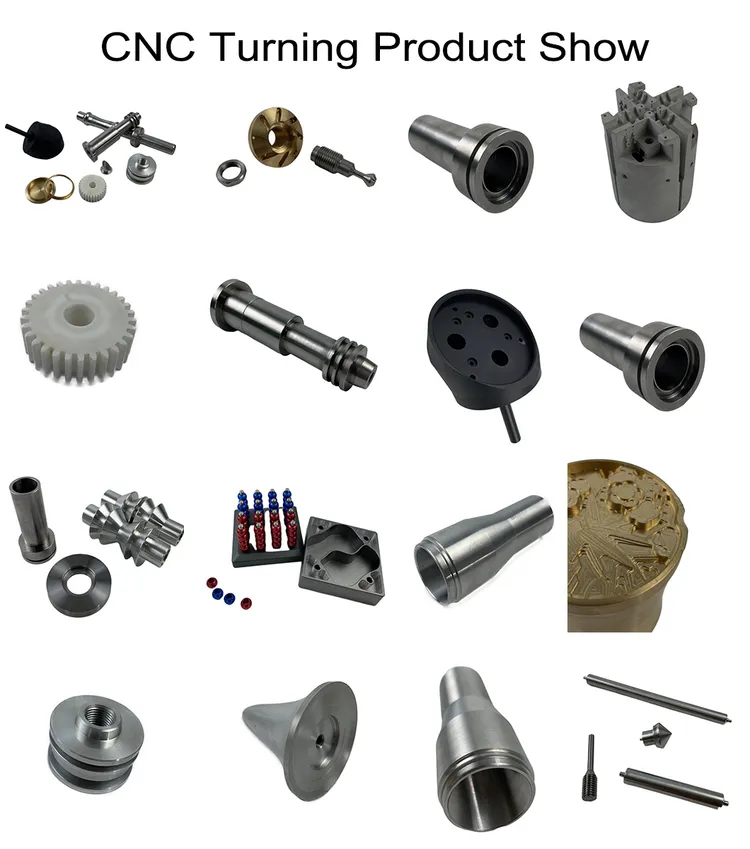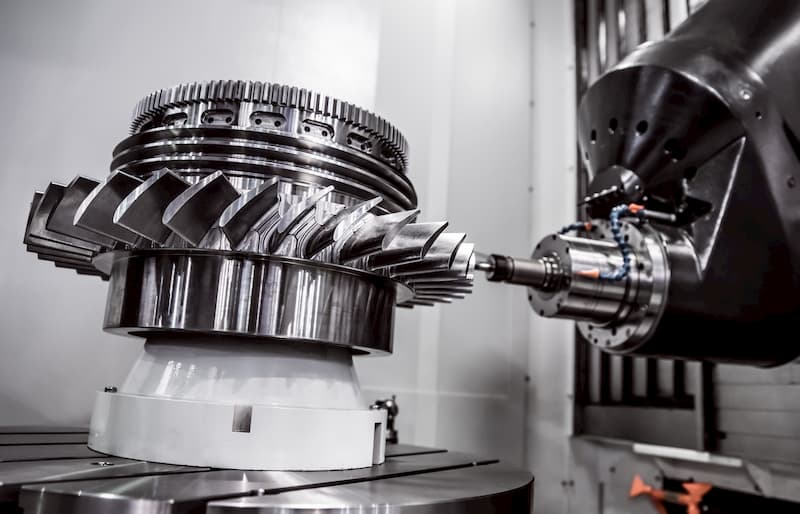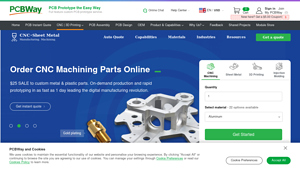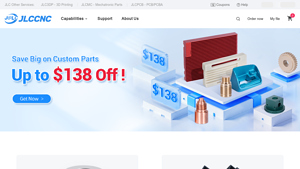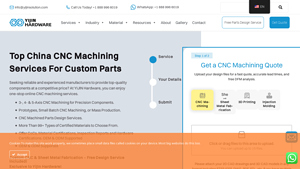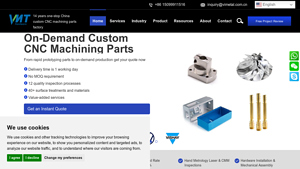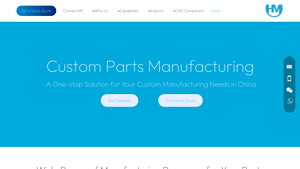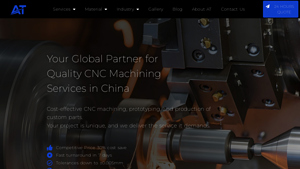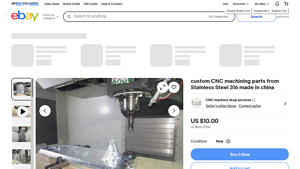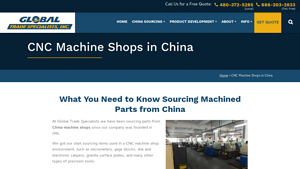Cnc Parts China Guide: Type, Cost, Top List…
Introduction: Navigating the Global Market for cnc parts china
In the competitive landscape of global manufacturing, sourcing high-quality CNC parts from China can be a daunting task for B2B buyers, especially those operating in diverse regions such as Africa, South America, the Middle East, and Europe. The intricacies of navigating supplier options, understanding manufacturing capabilities, and ensuring quality control can pose significant challenges. This guide aims to simplify the process of sourcing CNC parts from China by providing a comprehensive overview of key considerations, including the various types of CNC machining services available, their applications across different industries, and effective strategies for vetting suppliers.
As the demand for precision-engineered components continues to rise, understanding the nuances of the Chinese CNC market is crucial for making informed purchasing decisions. This guide empowers international buyers by outlining essential factors such as cost structures, lead times, and the importance of certifications. Additionally, it delves into the intricacies of managing logistics and communication with suppliers, ensuring that buyers can navigate potential pitfalls with confidence. By equipping B2B buyers with actionable insights and practical knowledge, this guide serves as a vital resource for establishing successful partnerships and achieving operational excellence in their sourcing endeavors.
Understanding cnc parts china Types and Variations
| Type Name | Key Distinguishing Features | Primary B2B Applications | Brief Pros & Cons for Buyers |
|---|---|---|---|
| CNC Milling Parts | Precision machining using rotating tools for complex shapes | Aerospace, automotive, industrial machinery | Pros: High precision, versatile materials; Cons: Longer lead times for complex designs. |
| CNC Turning Parts | Utilizes rotating workpieces for cylindrical components | Oil & gas, automotive, consumer goods | Pros: Excellent for symmetrical parts; Cons: Limited to round shapes. |
| CNC Sheet Metal Parts | Fabrication from metal sheets using cutting and bending | Construction, electronics, automotive | Pros: Cost-effective for mass production; Cons: May require additional finishing processes. |
| CNC Prototyping | Rapid prototyping services for quick iteration and testing | Product development, design validation | Pros: Fast turnaround, low initial investment; Cons: Limited to low-volume runs. |
| CNC 3D Printing Parts | Additive manufacturing for complex geometries | Medical, aerospace, custom designs | Pros: Highly customizable, minimal waste; Cons: Slower than traditional machining for high volumes. |
What Are CNC Milling Parts and Their Applications?
CNC milling parts are produced through a subtractive machining process that employs rotating cutting tools to shape materials into complex forms. This method is particularly suited for applications requiring high precision, such as aerospace and automotive components. Buyers should consider the type of material required, as CNC milling can accommodate metals, plastics, and composites. It’s essential to factor in the lead time, especially for intricate designs, as these can extend the production timeline.
How Do CNC Turning Parts Differ from Other Types?
CNC turning parts are crafted by rotating the workpiece against a stationary cutting tool, making them ideal for producing cylindrical shapes like shafts and fittings. Industries such as oil and gas, as well as consumer goods, frequently utilize these components due to their symmetrical nature. When purchasing, buyers should assess the complexity of the part design, as turning is limited to round shapes. Additionally, the material choice and tolerance specifications are vital for ensuring functionality in the intended application.
What Should Buyers Know About CNC Sheet Metal Parts?
CNC sheet metal parts are fabricated by cutting, bending, and assembling metal sheets, making them a popular choice in construction and electronics. They are particularly advantageous for mass production due to their cost-effectiveness. Buyers should consider the thickness and type of metal required, as well as any secondary processes needed for finishing. While these parts can be produced quickly, additional steps may be necessary to achieve the desired surface finish or functional characteristics.
Why Is CNC Prototyping Important for Product Development?
CNC prototyping is a rapid production technique that allows companies to create functional prototypes for testing and validation purposes. This method is critical for product development, enabling designers to iterate on their concepts quickly. B2B buyers should evaluate the prototyping service’s lead times and material options, as these factors can impact project timelines. While prototyping offers a low initial investment, it is typically best suited for low-volume runs before moving to mass production.
How Does CNC 3D Printing Enhance Custom Manufacturing?
CNC 3D printing utilizes additive manufacturing techniques to create complex geometries that would be challenging to achieve with traditional machining. This technology is increasingly popular in sectors like medical and aerospace, where customization is essential. Buyers should assess the compatibility of materials and the expected production speed, as 3D printing may not be suitable for high-volume orders compared to subtractive methods. However, its ability to minimize waste and allow for intricate designs makes it a valuable option for bespoke projects.
Key Industrial Applications of cnc parts china
| Industry/Sector | Specific Application of cnc parts china | Value/Benefit for the Business | Key Sourcing Considerations for this Application |
|---|---|---|---|
| Automotive | Production of precision engine components | Enhanced performance and reliability of vehicles | Material certifications, tolerance requirements, lead times |
| Aerospace & Aviation | Manufacturing of lightweight structural components | Improved fuel efficiency and safety in aircraft | Compliance with industry standards, quality control measures |
| Medical Devices | Creation of custom surgical instruments and implants | High precision and biocompatibility for patient safety | Certification for medical-grade materials, rapid prototyping |
| Consumer Electronics | Development of intricate housings and components | Competitive edge in product design and functionality | Quick turnaround times, customization options, cost efficiency |
| Industrial Machinery | Fabrication of parts for machinery and equipment | Increased productivity and reduced downtime in operations | Long-term partnerships, bulk order capabilities, technical support |
How Are CNC Parts from China Utilized in the Automotive Sector?
In the automotive industry, CNC parts from China play a vital role in producing precision engine components, such as cylinder heads, crankshafts, and fuel injectors. These components require stringent tolerances to ensure optimal performance and reliability. International buyers must prioritize suppliers with proven material certifications and a track record of meeting rigorous automotive standards. The ability to deliver parts quickly can also be a game-changer, enabling manufacturers to maintain production schedules without costly delays.
What is the Role of CNC Machining in Aerospace & Aviation?
The aerospace sector benefits significantly from CNC machining, particularly in the production of lightweight structural components like brackets and frames. These parts must adhere to strict safety regulations while minimizing weight to enhance fuel efficiency. Buyers in this sector should seek manufacturers that comply with aerospace industry standards and can provide comprehensive quality control measures. The ability to produce parts with high precision is crucial for maintaining the integrity of aircraft operations.
How Are CNC Parts Used in Medical Devices?
CNC parts are essential in the medical device industry, where custom surgical instruments and implants are manufactured. The need for high precision and biocompatibility is paramount, as these devices directly impact patient safety. International buyers should look for manufacturers that offer certification for medical-grade materials and can facilitate rapid prototyping to meet urgent project timelines. Ensuring compliance with health regulations is critical for successful market entry.
Why Are CNC Machined Components Important for Consumer Electronics?
In the consumer electronics sector, CNC parts are used to develop intricate housings and components that enhance product design and functionality. The competitive landscape necessitates rapid development cycles, making quick turnaround times a vital consideration for international buyers. Customization options can also provide a significant advantage in meeting specific market needs. Partnering with a reliable CNC supplier can help businesses maintain a competitive edge while ensuring cost efficiency.
How Do CNC Parts Benefit the Industrial Machinery Sector?
CNC machining services are crucial for fabricating parts used in industrial machinery and equipment. These components directly influence productivity and operational efficiency. Buyers should consider suppliers that can support long-term partnerships and offer bulk order capabilities to meet ongoing production needs. Technical support is also an essential factor, as it ensures that any issues can be resolved quickly, minimizing downtime and maintaining workflow.
3 Common User Pain Points for ‘cnc parts china’ & Their Solutions
Scenario 1: Navigating Quality Control in CNC Parts Sourcing
The Problem: One of the primary concerns for B2B buyers sourcing CNC parts from China is ensuring consistent quality and compliance with international standards. Many buyers face challenges such as receiving parts that do not meet specifications, leading to costly production delays and potential damage to their reputation. The lack of transparency in quality assurance processes can make it difficult for companies to trust that their suppliers will deliver parts that are both precise and reliable.
The Solution: To mitigate quality control issues, buyers should implement a comprehensive supplier evaluation process. Start by requesting detailed documentation from potential suppliers, including Certificates of Compliance (CoCs), inspection reports, and material certifications. Engage in dialogue with suppliers about their quality assurance processes, including any certifications they hold (such as ISO 9001). Consider ordering prototypes before committing to large-scale production to assess quality firsthand. Additionally, establishing clear communication channels and setting up regular check-ins during the manufacturing process can help ensure that any quality concerns are addressed promptly.
Scenario 2: Overcoming Language Barriers and Communication Gaps
The Problem: Language barriers can create significant challenges in communication between international buyers and Chinese CNC manufacturers. Misunderstandings regarding specifications, timelines, and quality expectations can lead to production errors and delays, frustrating both parties. This issue is particularly pronounced for buyers from regions with less familiarity with Chinese business practices, such as Africa and South America.
The Solution: To enhance communication, buyers should consider using professional translation services when drafting specifications and contracts. This investment can help ensure that all technical details are clearly understood by both parties. Additionally, leveraging online collaboration tools that include visual aids, such as diagrams and videos, can facilitate better understanding. Establishing a dedicated point of contact who is fluent in both languages can also streamline communications and help clarify any questions or concerns that arise during the project.
Scenario 3: Managing Lead Times and Delivery Schedules
The Problem: Timely delivery of CNC parts is critical for maintaining production schedules, yet many international buyers report long lead times and unpredictable shipping delays when sourcing from China. Factors such as customs clearance, production bottlenecks, and inadequate planning can exacerbate these issues, leading to costly interruptions in the supply chain.
The Solution: To effectively manage lead times, buyers should prioritize suppliers that offer transparent timelines and have a proven track record of meeting deadlines. Utilize online platforms that provide real-time tracking of orders to stay updated on production and shipping statuses. Consider establishing buffer stock agreements with suppliers to mitigate the impact of potential delays. Additionally, fostering a strong relationship with logistics providers can help navigate customs processes more smoothly, ensuring that shipments arrive on time. When possible, negotiate terms that include penalties for late deliveries to reinforce the importance of adherence to schedules.
Strategic Material Selection Guide for cnc parts china
What Are the Key Properties of Common Materials Used in CNC Parts from China?
When selecting materials for CNC parts in China, understanding their properties is crucial. Here, we analyze four common materials: aluminum, stainless steel, brass, and plastics. Each material has unique characteristics affecting performance, cost, and suitability for various applications.
How Does Aluminum Perform in CNC Machining?
Aluminum is one of the most widely used materials in CNC machining due to its excellent strength-to-weight ratio and corrosion resistance. It can withstand moderate temperatures and pressures, making it suitable for various applications, including automotive and aerospace components.
Pros: Aluminum is lightweight, making it ideal for applications where weight reduction is essential. It is also relatively easy to machine, leading to lower manufacturing costs and shorter lead times.
Cons: However, aluminum has lower tensile strength compared to steel and can be prone to deformation under high stress. Its cost can vary, but it is generally considered a medium-cost material.
Impact on Application: Aluminum is compatible with various media, including air and water, but may not be suitable for high-pressure applications without proper treatment.
Considerations for International Buyers: Buyers from regions like Europe and the Middle East should ensure compliance with standards such as ASTM and DIN for quality assurance.
What Are the Advantages of Using Stainless Steel for CNC Parts?
Stainless steel is renowned for its durability and resistance to corrosion and oxidation. It can handle high temperatures and pressures, making it suitable for demanding environments like the oil and gas industry.
Pros: Its strength and resistance to wear make stainless steel an excellent choice for parts exposed to harsh conditions. It also has a longer lifespan, which can reduce long-term costs.
Cons: The machining process for stainless steel can be more complex and time-consuming, leading to higher production costs.
Impact on Application: Stainless steel is compatible with a wide range of media, including chemicals, making it ideal for medical and food processing applications.
Considerations for International Buyers: Compliance with international standards is crucial, especially for industries that require stringent quality controls, such as medical or aerospace sectors.
Why Choose Brass for CNC Machining Parts?
Brass is a copper-zinc alloy known for its machinability and excellent corrosion resistance. It is often used for electrical components and fittings due to its good conductivity.
Pros: Brass is easy to machine and has a pleasing aesthetic finish, making it suitable for decorative applications. It also has good resistance to corrosion in a variety of environments.
Cons: However, brass is less strong than stainless steel and can be more expensive, depending on the alloy used.
Impact on Application: Brass is particularly effective in applications where electrical conductivity is essential, such as in connectors and terminals.
Considerations for International Buyers: Buyers should be aware of the specific alloy standards and certifications required in their regions, especially in Europe where regulations can be stringent.
What Role Do Plastics Play in CNC Machining?
Plastics, including ABS, nylon, and POM, are increasingly popular in CNC machining due to their lightweight and versatile properties. They can be engineered to meet specific performance requirements, including temperature and chemical resistance.
Pros: Plastics are generally low-cost and easy to machine, allowing for rapid prototyping and production. They can also be tailored for specific applications, enhancing their suitability.
Cons: However, plastics may not provide the same level of strength or durability as metals and can be sensitive to temperature variations.
Impact on Application: Plastics are suitable for applications where weight is a concern or where electrical insulation is required, such as in consumer electronics.
Considerations for International Buyers: Buyers should consider the environmental regulations regarding plastic use in their regions, particularly in Europe, where sustainability is a growing concern.
Summary Table of Material Selection for CNC Parts in China
| Material | Typical Use Case for cnc parts china | Key Advantage | Key Disadvantage/Limitation | Relative Cost (Low/Med/High) |
|---|---|---|---|---|
| Aluminum | Automotive and aerospace components | Lightweight and good corrosion resistance | Lower tensile strength than steel | Medium |
| Stainless Steel | Oil and gas, medical devices | High durability and temperature resistance | Higher machining complexity | High |
| Brass | Electrical components and fittings | Excellent machinability and conductivity | Less strength than stainless steel | Medium to High |
| Plastics | Consumer electronics and prototypes | Low-cost and versatile | Less strength and temperature sensitivity | Low |
This guide provides a comprehensive overview of material selection for CNC parts in China, helping international buyers make informed decisions that align with their project requirements and compliance standards.
In-depth Look: Manufacturing Processes and Quality Assurance for cnc parts china
What Are the Key Stages in the Manufacturing Process for CNC Parts in China?
The manufacturing process for CNC parts in China typically involves several critical stages: material preparation, forming, assembly, and finishing.
-
Material Preparation: The process begins with the selection of raw materials, which can include metals such as aluminum, stainless steel, and titanium, or plastics like nylon and POM. Suppliers often provide a wide variety of certified materials to ensure quality and compliance with industry standards. Upon selection, the materials undergo inspection to confirm they meet the required specifications before moving to the next stage.
-
Forming: This stage employs advanced CNC machining techniques, including milling, turning, and drilling. Chinese manufacturers often utilize multi-axis machines (3-, 4-, and 5-axis) to produce complex geometries with high precision. The choice of technique depends on the part design and material type. High-speed machining and adaptive control technologies are increasingly common, allowing for better efficiency and reduced lead times.
-
Assembly: After individual components are machined, they may require assembly. This can include joining multiple machined parts or integrating electronic components, depending on the product’s complexity. Manufacturers may offer assembly services, ensuring that parts fit together seamlessly and function as intended.
-
Finishing: The final stage involves surface treatment and finishing processes to enhance the part’s aesthetics and performance. Common finishing techniques include anodizing, powder coating, and polishing. The choice of finishing is essential not only for appearance but also for corrosion resistance and wear protection.
How is Quality Assurance Implemented in CNC Manufacturing in China?
Quality assurance (QA) in CNC manufacturing is paramount, especially for international B2B buyers who require consistent quality and compliance with specific standards. Here are the key components of QA in this context:
-
International Standards Compliance: Many Chinese manufacturers adhere to international quality management systems such as ISO 9001, ensuring that they maintain consistent quality throughout the manufacturing process. For industry-specific products, compliance with standards like CE for European markets or API for oil and gas components is also crucial.
-
Quality Checkpoints: Quality control is integrated at various checkpoints throughout the manufacturing process:
– Incoming Quality Control (IQC): Raw materials are inspected upon arrival to ensure they meet the specified criteria.
– In-Process Quality Control (IPQC): Regular checks are conducted during machining to monitor tolerances and dimensions.
– Final Quality Control (FQC): Completed parts undergo a final inspection to verify they meet all design specifications and quality standards. -
Testing Methods: Common testing methods include dimensional inspections using calipers and gauges, surface roughness measurements, and non-destructive testing techniques like ultrasonic and X-ray inspection. Manufacturers may also conduct functional testing, especially for complex assemblies.
How Can B2B Buyers Verify Supplier Quality Control Practices?
B2B buyers can take several proactive steps to verify the quality control practices of their suppliers in China:
-
Supplier Audits: Conducting on-site audits can provide invaluable insights into the manufacturer’s operations, quality control systems, and compliance with international standards. This can help buyers assess the supplier’s capability and commitment to quality.
-
Requesting Documentation: Buyers should request certificates of compliance, inspection reports, and quality assurance documentation. These documents can confirm that the supplier adheres to relevant standards and has robust QA processes in place.
-
Third-Party Inspections: Engaging a third-party inspection agency can help ensure that the parts meet the required specifications before shipment. This is particularly important for large orders or complex components where quality is critical.
What Are the Quality Control and Certification Nuances for International B2B Buyers?
Understanding the nuances of quality control and certification can help international buyers navigate the complexities of sourcing CNC parts from China:
-
Cultural and Language Barriers: Effective communication is essential. Buyers should ensure that they clearly articulate their quality requirements and expectations, as misunderstandings can lead to non-compliance with standards.
-
Certifications and Compliance: Different countries have varying regulations and standards. For instance, European buyers may prioritize CE marking, while buyers from the Middle East may require compliance with local standards. Understanding these nuances can help buyers select suppliers who can meet their specific needs.
-
Lead Times and Flexibility: Buyers should be aware that while many Chinese manufacturers offer rapid prototyping and short lead times, the complexities of quality assurance may require additional time. Planning for this can help avoid delays in the supply chain.
-
Long-Term Relationships: Establishing long-term partnerships with reliable suppliers can enhance quality assurance over time. Continuous communication and feedback can help suppliers improve their processes and meet evolving buyer expectations.
Conclusion
B2B buyers sourcing CNC parts from China can benefit from understanding the manufacturing processes and quality assurance practices in place. By focusing on key stages of manufacturing, verifying quality control measures, and recognizing certification nuances, buyers can make informed decisions that support their operational goals and ensure product quality.
Practical Sourcing Guide: A Step-by-Step Checklist for ‘cnc parts china’
The purpose of this guide is to assist international B2B buyers in effectively sourcing CNC parts from China. By following this step-by-step checklist, you can streamline your procurement process and ensure that you partner with reliable suppliers who meet your specific needs.
Step 1: Define Your Technical Specifications
Clearly outline the technical specifications for the CNC parts you require. This includes dimensions, tolerances, material types, and any specific finishing processes. Precise specifications help potential suppliers understand your requirements and avoid miscommunication, which can lead to costly errors.
Step 2: Research Potential Suppliers
Conduct thorough research to identify potential suppliers in China. Utilize online platforms and directories, such as Alibaba or Global Sources, and read reviews from other buyers. Look for suppliers with a solid reputation and experience in your industry to ensure quality and reliability.
Step 3: Evaluate Supplier Certifications
It’s essential to verify that your chosen suppliers hold relevant certifications, such as ISO 9001 or specific industry certifications. These certifications indicate that the supplier adheres to quality management standards, which is crucial for maintaining product quality. Request copies of certifications and check their validity.
Step 4: Request Quotes and Compare Pricing
After narrowing down your supplier options, request detailed quotes that include pricing, lead times, and payment terms. Compare these quotes carefully, taking into account not only cost but also the quality of materials and services offered. Be wary of prices that seem too low, as they may indicate lower quality or hidden costs.
Step 5: Ask for Samples
Before placing a large order, request samples of the CNC parts. This step allows you to assess the quality of the supplier’s work and ensures that the parts meet your specifications. Evaluate the samples for precision, finish, and overall quality to make an informed decision.
Step 6: Understand Shipping and Customs Requirements
Familiarize yourself with the shipping and customs requirements for importing CNC parts from China to your country. This includes understanding tariffs, taxes, and potential delays in customs clearance. Working with a supplier who has experience in international shipping can help mitigate these challenges.
Step 7: Establish Clear Communication Channels
Effective communication is vital throughout the sourcing process. Ensure that you have established clear channels for communication with your supplier, including preferred languages and response times. Regular updates and open dialogue will help address any issues promptly and build a strong working relationship.
By following these steps, you can navigate the complexities of sourcing CNC parts from China effectively. This proactive approach will help you secure high-quality components that meet your specifications while minimizing risks associated with international procurement.
Comprehensive Cost and Pricing Analysis for cnc parts china Sourcing
What Are the Key Cost Components in CNC Parts Sourcing from China?
When sourcing CNC parts from China, understanding the cost structure is crucial for effective budgeting and pricing negotiations. The primary cost components include:
-
Materials: The choice of materials significantly impacts the cost. Common materials like aluminum and plastic are generally more affordable compared to specialized alloys or composites. Prices fluctuate based on global demand and availability, so it’s essential to stay updated on market trends.
-
Labor: China’s labor costs are competitive, but they vary by region and skill level. Skilled labor for high-precision machining will incur higher costs. However, overall labor expenses are still lower than in many Western countries, which can be advantageous for bulk orders.
-
Manufacturing Overhead: This includes utilities, equipment depreciation, and factory maintenance. Efficient manufacturers often have streamlined processes that minimize overhead costs, allowing them to offer more competitive pricing.
-
Tooling: Initial tooling costs can be significant, especially for custom parts requiring specialized molds or jigs. It’s crucial to factor in these costs early, particularly for low-volume runs where tooling can represent a larger portion of the total cost.
-
Quality Control (QC): Implementing rigorous QC processes incurs additional costs, but it ensures that the parts meet international standards and specifications. Many reputable manufacturers provide certification and inspection reports as part of their service.
-
Logistics: Shipping costs can vary widely based on the chosen Incoterms, shipping method, and destination. Understanding these factors can help buyers negotiate better shipping rates and timelines.
-
Margin: Suppliers will add their profit margin to the cost of production, which can vary based on their business model and market positioning.
How Do Price Influencers Affect CNC Parts Pricing?
Several factors influence the pricing of CNC parts, including:
-
Volume/MOQ: Higher order volumes typically lead to lower unit prices due to economies of scale. Manufacturers are often more willing to negotiate on price for larger orders.
-
Specifications and Customization: Custom designs or intricate specifications may lead to higher costs due to the additional labor and tooling required. Simple designs tend to be more cost-effective.
-
Materials: As previously mentioned, the choice of materials can greatly affect pricing. Additionally, specific certifications for materials can also add to the cost.
-
Quality and Certifications: Parts that require higher quality standards or certifications (such as ISO or RoHS) may come at a premium. Buyers should assess whether these certifications are necessary for their applications.
-
Supplier Factors: The reputation and capabilities of the supplier can influence pricing. Established suppliers with a track record of quality may charge more, but they can also reduce risk.
-
Incoterms: The agreed-upon Incoterms (such as FOB, CIF, etc.) will impact the total landed cost. Understanding these terms is essential for accurate cost assessments.
What Are the Best Tips for Buyers to Optimize Costs?
International B2B buyers, especially from regions like Africa, South America, the Middle East, and Europe, can employ several strategies to enhance cost-efficiency:
-
Negotiate Effectively: Always approach negotiations with a clear understanding of your budget and desired specifications. Building a good relationship with suppliers can also lead to better pricing and terms.
-
Consider Total Cost of Ownership (TCO): Look beyond the initial price. Consider factors like durability, maintenance, and logistics when evaluating suppliers. A lower upfront cost may result in higher long-term expenses.
-
Be Aware of Pricing Nuances: Understand that prices can fluctuate based on market conditions and geopolitical factors. Regularly reassess supplier pricing and be prepared to switch suppliers if necessary.
-
Leverage Technology: Utilize online platforms for instant quotes and comparisons. This allows for quick assessments of different suppliers’ pricing and capabilities.
-
Request Multiple Quotes: Don’t settle for the first quote. Gathering multiple proposals can provide leverage in negotiations and help identify the best value.
Disclaimer on Indicative Prices
Prices for CNC parts can vary significantly based on numerous factors, including but not limited to material costs, order volumes, and specific requirements. The information provided in this analysis serves as a general guideline and should not be considered as fixed pricing. Always seek updated quotes from suppliers to obtain the most accurate cost assessments for your specific needs.
Alternatives Analysis: Comparing cnc parts china With Other Solutions
Exploring Viable Alternatives to CNC Parts from China
In the dynamic landscape of manufacturing, buyers often seek various solutions to fulfill their needs for precision components. While CNC parts from China are renowned for their cost-effectiveness and efficiency, other alternatives may better suit specific project requirements. This analysis compares CNC parts from China with 3D printing and local CNC machining services, providing B2B buyers with comprehensive insights.
| Comparison Aspect | Cnc Parts China | 3D Printing | Local CNC Machining Services |
|---|---|---|---|
| Performance | High precision, varied materials | Versatile, but less precise than CNC | High precision, limited by machine capabilities |
| Cost | Competitive, especially in bulk | Generally higher for small batches | Varies significantly based on location and complexity |
| Ease of Implementation | Streamlined online ordering | Requires design expertise | Can be complex, depending on service provider |
| Maintenance | Minimal, handled by the supplier | Low, but requires design updates | Higher, due to equipment upkeep |
| Best Use Case | Mass production of complex parts | Prototyping and low-volume production | Custom, high-precision parts in low to medium volumes |
What Are the Pros and Cons of 3D Printing as an Alternative?
3D printing has emerged as a popular alternative to traditional CNC machining, particularly for prototyping and producing low-volume parts. Its key advantage lies in its flexibility; it allows for complex geometries and rapid iterations without the need for expensive tooling. However, the precision may not match that of CNC machining, especially for functional parts requiring tight tolerances. Additionally, while the initial setup costs can be lower, the cost per unit can rise significantly for larger production runs, making it less economical compared to CNC parts from China.
How Do Local CNC Machining Services Compare?
Local CNC machining services offer the benefit of proximity, which can lead to faster turnaround times and easier communication. These services often provide high precision and can accommodate custom designs. However, they may not be as cost-effective as sourcing from China, especially for bulk orders. Additionally, the availability of specific materials and technologies may be limited compared to larger Chinese manufacturers. For businesses focused on local sourcing or those with unique compliance requirements, local CNC machining can be an excellent choice despite potentially higher costs.
Conclusion: How to Choose the Right Solution for Your Needs
When selecting a solution for precision components, B2B buyers should carefully evaluate their specific requirements, including production volume, complexity, and budget constraints. CNC parts from China offer a compelling option for mass production and cost efficiency, while 3D printing excels in flexibility and rapid prototyping. Local CNC services may be ideal for companies prioritizing quick delivery and personalized service. Ultimately, the best choice will depend on balancing these factors to align with your project goals and operational needs.
Essential Technical Properties and Trade Terminology for cnc parts china
What Are the Key Technical Properties of CNC Parts from China?
When sourcing CNC parts from China, understanding the technical specifications is essential for ensuring product quality and meeting project requirements. Here are some critical properties to consider:
-
Material Grade
The material used in CNC parts significantly impacts their performance and durability. Common materials include aluminum, stainless steel, brass, and various plastics. Each material has specific grades that define its mechanical properties, such as tensile strength and corrosion resistance. For B2B buyers, selecting the right material grade is crucial for ensuring that the parts can withstand the intended application. -
Tolerance
Tolerance refers to the allowable deviation from a specified dimension. In CNC machining, tight tolerances (as low as ±0.01 mm) can be achieved, which is essential for applications requiring high precision, such as aerospace and medical devices. B2B buyers should specify tolerance levels to avoid costly rework or product failures, ensuring that parts fit correctly in assemblies. -
Surface Finish
The surface finish of CNC parts affects aesthetics, functionality, and durability. Common finishes include anodizing, bead blasting, and polishing. A good surface finish can enhance corrosion resistance and reduce friction. Buyers should specify surface finish requirements to align with their product needs and industry standards. -
Lead Time
Lead time is the duration from order placement to delivery. In CNC machining, lead times can vary from a few days for prototypes to weeks for larger production runs. Understanding lead times helps B2B buyers plan their supply chain and manage project timelines effectively. -
Production Volume
CNC machining services can accommodate various production volumes, from low-volume prototyping to mass production. Buyers should clarify their needs, as different volumes may affect pricing and manufacturing processes. This understanding helps in budgeting and aligning production capabilities with demand.
What Are Common Trade Terms Used in CNC Parts Sourcing?
Familiarizing yourself with industry jargon can facilitate smoother communication with manufacturers. Here are some common trade terms relevant to CNC parts sourcing:
-
OEM (Original Equipment Manufacturer)
OEM refers to companies that produce parts that are used in another company’s end products. For B2B buyers, working with OEMs can provide custom solutions tailored to specific requirements, ensuring compatibility and quality. -
MOQ (Minimum Order Quantity)
MOQ is the smallest quantity of products that a supplier is willing to sell. Understanding the MOQ is vital for buyers to avoid overcommitting to orders that exceed their needs and budget. It can also influence decisions on whether to source from a particular supplier. -
RFQ (Request for Quotation)
An RFQ is a document sent to suppliers requesting pricing and terms for specific parts. B2B buyers use RFQs to compare offers from different manufacturers, ensuring they get competitive pricing and favorable conditions for their projects. -
Incoterms (International Commercial Terms)
Incoterms define the responsibilities of buyers and sellers in international trade, including shipping costs, risk transfer, and delivery points. Understanding Incoterms is essential for B2B buyers to negotiate contracts effectively and ensure clarity in shipping arrangements. -
CNC (Computer Numerical Control)
CNC refers to the automated control of machining tools via computer programming. This technology enables high precision and repeatability in manufacturing. For B2B buyers, knowing about CNC capabilities can help in selecting manufacturers that meet their specific production needs. -
Post-Processing
Post-processing involves additional finishing steps after the primary machining is completed, such as polishing, painting, or coating. This term is significant for buyers who want to enhance the functionality or appearance of their parts, ensuring they meet industry standards and customer expectations.
By understanding these technical properties and trade terms, international B2B buyers can make informed decisions when sourcing CNC parts from China, leading to better project outcomes and stronger supplier relationships.
Navigating Market Dynamics and Sourcing Trends in the cnc parts china Sector
What Are the Key Market Dynamics and Trends Affecting CNC Parts Sourcing in China?
The global CNC parts market is witnessing significant transformation driven by technological advancements, increasing demand for precision manufacturing, and the need for rapid prototyping. International B2B buyers, particularly from Africa, South America, the Middle East, and Europe, are increasingly turning to Chinese manufacturers due to their ability to offer high-quality components at competitive prices. The rise of online platforms facilitating instant quotes and streamlined ordering processes has made sourcing from China more accessible than ever. Additionally, the integration of Industry 4.0 technologies, such as IoT and AI, is enhancing production efficiency and quality control, making Chinese CNC machining services more appealing to global buyers.
Emerging trends include a shift towards custom and low-volume production runs, allowing businesses to respond quickly to market changes. The demand for specialized materials, including advanced composites and high-performance plastics, is also on the rise, enabling manufacturers to cater to diverse industries from aerospace to consumer electronics. Furthermore, the ongoing global supply chain disruptions are prompting companies to diversify their supplier base, leading to an increased interest in sourcing CNC parts from China. This dynamic environment presents ample opportunities for international buyers to leverage China’s manufacturing capabilities while ensuring their supply chains remain resilient.
How Are Sustainability and Ethical Sourcing Shaping the CNC Parts Market in China?
Sustainability is becoming a critical concern for B2B buyers in the CNC parts sector. The environmental impact of manufacturing processes is prompting companies to seek suppliers committed to sustainable practices. Chinese manufacturers are increasingly adopting green certifications and eco-friendly materials to meet the growing demand for responsible sourcing. Certifications such as ISO 14001 for environmental management systems and adherence to RoHS (Restriction of Hazardous Substances) guidelines are becoming essential criteria for international buyers evaluating potential suppliers.
Moreover, ethical sourcing is gaining traction, with buyers prioritizing suppliers that uphold labor rights and fair working conditions. By choosing manufacturers that demonstrate a commitment to ethical practices, businesses can enhance their brand reputation and align with the values of environmentally and socially conscious consumers. As a result, Chinese CNC machining companies that focus on sustainability and ethical sourcing are better positioned to attract international clients and foster long-term partnerships.
How Has the CNC Parts Sector Evolved to Meet Global Demand?
The evolution of the CNC parts sector in China has been marked by a shift from traditional manufacturing to advanced digital processes. Initially, the industry focused on mass production, but as global demand for customization and precision increased, manufacturers began investing in state-of-the-art CNC machines capable of 3-, 4-, and 5-axis machining. This transition enabled Chinese suppliers to offer a wider range of services, including rapid prototyping and low-volume production, which are essential for industries like automotive and aerospace.
Over the past two decades, the integration of digital technologies has further transformed the landscape, allowing for real-time tracking and improved quality assurance. The rise of online platforms has simplified the sourcing process, enabling international buyers to obtain instant quotes and manage orders efficiently. As a result, China’s CNC machining sector has solidified its position as a global leader, catering to the evolving needs of international businesses seeking high-quality, cost-effective manufacturing solutions.
Frequently Asked Questions (FAQs) for B2B Buyers of cnc parts china
-
How do I ensure the quality of CNC parts sourced from China?
To ensure quality when sourcing CNC parts from China, it is essential to conduct thorough supplier vetting. Start by checking certifications like ISO 9001, which indicates a robust quality management system. Request samples to evaluate the manufacturing standards and tolerances. Utilize third-party inspection services to verify quality before shipment. Establish clear quality expectations in your contracts, including acceptable defect rates and detailed specifications. Engaging in regular communication with your supplier throughout the production process also helps maintain quality assurance. -
What is the typical lead time for custom CNC parts from China?
Lead times for custom CNC parts can vary widely based on complexity, order volume, and the supplier’s capabilities. Generally, you can expect lead times to range from 2 to 4 weeks for prototypes, while larger production runs may take 4 to 8 weeks or more. Suppliers often provide expedited services, which can shorten lead times significantly. It is advisable to discuss timelines upfront with your supplier and factor in shipping time, especially for international orders, to align with your project deadlines. -
What are the minimum order quantities (MOQ) for CNC parts from Chinese manufacturers?
Minimum order quantities (MOQ) for CNC parts can differ significantly between suppliers. Some manufacturers might accept orders as low as 1 piece for prototypes, while others may have MOQs ranging from 100 to 1,000 units for mass production. It’s crucial to communicate your needs clearly and negotiate MOQs based on your project requirements. Many suppliers are flexible and can accommodate lower quantities, especially for first-time clients, to build long-term relationships. -
How can I customize CNC parts for my specific needs?
Customizing CNC parts involves providing detailed specifications and designs to the manufacturer. Utilize CAD software to create precise 3D models and share them with your supplier. Discuss material choices, surface finishes, and tolerances to ensure the parts meet your requirements. Most Chinese manufacturers offer design assistance to help refine your ideas into manufacturable products. Clear communication and documentation are key to achieving the desired customizations while avoiding costly revisions. -
What payment terms should I expect when sourcing CNC parts from China?
Payment terms can vary by supplier but typically include options like a 30% deposit upfront and the remaining 70% upon completion or before shipment. Some suppliers might offer payment through secure platforms like PayPal or bank transfers. It’s essential to clarify payment terms in your contract to avoid misunderstandings. Additionally, consider using a letter of credit for larger transactions as it provides added security. Always ensure the payment method is safe and reliable to protect your financial interests. -
What logistics options are available for shipping CNC parts from China?
Logistics for shipping CNC parts from China can include air freight, sea freight, and express courier services. Air freight is faster but more expensive, making it suitable for urgent orders, while sea freight is cost-effective for larger shipments but takes longer. Many suppliers offer door-to-door services, handling customs clearance and delivery. Be sure to discuss logistics options with your supplier and consider working with a freight forwarder for better coordination and tracking of your shipments. -
How do I handle communication with suppliers in China?
Effective communication with Chinese suppliers is vital for successful partnerships. Use clear, concise language and avoid jargon to prevent misunderstandings. Tools like email, video conferencing, and instant messaging apps (e.g., WeChat) are commonly used. It’s beneficial to establish a primary point of contact within the supplier’s organization. Be mindful of time zone differences and cultural nuances, as they can affect response times and expectations. Regular updates and feedback will foster a collaborative relationship. -
What are the common certifications for CNC parts, and why are they important?
Common certifications for CNC parts include ISO 9001 for quality management and ISO 13485 for medical devices. Other relevant certifications may include CE marking for products sold in Europe and RoHS compliance for environmental safety. These certifications are important as they demonstrate a manufacturer’s commitment to quality, safety, and regulatory compliance. Sourcing from certified suppliers reduces the risk of defects and enhances trust in the supply chain, which is crucial for maintaining product integrity in competitive markets.
Important Disclaimer & Terms of Use
⚠️ Important Disclaimer
The information provided in this guide, including content regarding manufacturers, technical specifications, and market analysis, is for informational and educational purposes only. It does not constitute professional procurement advice, financial advice, or legal advice.
While we have made every effort to ensure the accuracy and timeliness of the information, we are not responsible for any errors, omissions, or outdated information. Market conditions, company details, and technical standards are subject to change.
B2B buyers must conduct their own independent and thorough due diligence before making any purchasing decisions. This includes contacting suppliers directly, verifying certifications, requesting samples, and seeking professional consultation. The risk of relying on any information in this guide is borne solely by the reader.
Top 8 Cnc Parts China Manufacturers & Suppliers List
1. PCBWay – CNC Machining & 3D Printing Services
Domain: pcbway.com
Registered: 2012 (13 years)
Introduction: CNC Machining Service: Includes CNC Milling (3-, 4- & full 5-axis) and CNC Turning. 3D Printing Service: Offers various methods including SLA, DLP, FDM, SLM, SLS, PolyJet, and Vacuum Casting. Sheet Metal Fabrication: Services include laser cutting and bending. Injection Molding Service: Provides rapid molds and custom molded prototypes. Materials: CNC machining materials include aluminum, stainles…
2. JLCCNC – CNC Machining & 3D Printing Services
Domain: jlccnc.com
Registered: 2021 (4 years)
Introduction: CNC Machining Services: CNC Milling (3-, 4-, & full 5-axis), CNC Turning, EDM. Materials: Aluminum, Copper, Plastic. Tolerance: down to 0.05mm. Lead time: from 3 business days. 3D Printing Services: SLA, MJF, SLM, FDM, SLS, WJP. Materials: Resin, Nylon, Metal, Plastic. Tolerance: down to 0.2mm. Lead time: from 2 business days. In-house production with cutting-edge technology. Rapid cost-effective …
3. Yijin Hardware – CNC Machining Services
Domain: yijinsolution.com
Registered: 2019 (6 years)
Introduction: Yijin Hardware offers a wide range of CNC machining services including CNC Turning, CNC Milling, 5 Axis CNC Machining, and Rapid Prototyping. They provide custom parts manufacturing for various industries such as Aerospace, Automotive, Consumer Products, Energy, Medical, Maritime, Defense, Semiconductor, and Robotics. The materials available for machining include various plastics (ABS, Acetal, HDP…
4. Machining Custom – CNC Machined Parts
Domain: machining-custom.com
Registered: 2015 (10 years)
Introduction: CNC Machined Parts Factory – Custom CNC Turning Milling Service Manufacturer in China. Services include CNC Machining, CNC Milling, CNC Turning, 5 Axis CNC Machining, CNC Prototype Machining, Precision CNC Machining, and Swiss CNC Machining. Industries served: Automotive, Robotics, Electronics, Medical, Industrial. Materials used: Aluminum, Stainless Steel, Brass, Titanium, Plastic. Quality assura…
5. HMaking – Custom CNC Parts Manufacturer
Domain: hmaking.com
Registered: 2021 (4 years)
Introduction: Custom High Precision CNC Parts Manufacturer in China. Capabilities include CNC Machining, CNC Turning, CNC Milling, and CNC Drilling. Materials processed: Aluminum (various alloys), Steel (carbon, stainless), Brass, and Zinc. Offers sample prototyping and mass production (5 million parts/year). Certifications: ISO9001, ISO14001, ISO45001, TS16949. Advanced equipment with tolerances of 0.002um. Su…
6. At Machining – CNC Machining Services
Domain: at-machining.com
Registered: 2014 (11 years)
Introduction: Top China CNC Machining Service, Quick, Accurate, Flexible, No MOQ. Services include CNC Machining Services, CNC Milling Services, CNC Turning Services, Precision 5-Axis CNC Machining Services, Swiss CNC Machining Services, Small Batch CNC Machining Services, Precision Micro Machining Services, Sheet Metal Fabrication, Surface Finishing Services (Anodizing, Electroplating, Powder Coating), Carburi…
7. NingBo DaFangDing – Custom CNC Machining Parts
Domain: ebay.com
Registered: 1995 (30 years)
Introduction: {“product_name”: “Custom CNC Machining Parts”, “material”: “Stainless Steel 316”, “condition”: “New”, “location”: “NingBo, China”, “price”: “US $10.00”, “shipping_cost”: “US $30.00”, “shipping_service”: “UPS Worldwide Saver”, “returns”: “30 days returns accepted”, “seller”: “NingBo DaFangDing Machinery Technology Co.,Ltd”, “services_offered”: [“CNC machining services”, “Fixture Design and Build”, …
8. MG Trading – CNC Machined Parts
Domain: mgtrading.com
Registered: 1998 (27 years)
Introduction: CNC machined parts including anodized aluminum housing, brass threaded insert, o-ring, and fasteners; materials available include aluminum, carbon steel, stainless steel, cast iron, ductile iron, plastics, brass, copper, titanium, and Inconel; capabilities include CNC machining and turning, surface grinding, extrusions, assembly, welding, castings and forgings, wire EDM, die castings; tolerances t…
Strategic Sourcing Conclusion and Outlook for cnc parts china
In navigating the complexities of sourcing CNC parts from China, international buyers can leverage a wealth of opportunities that promise both quality and efficiency. The strategic sourcing process allows businesses to tap into China’s advanced manufacturing capabilities, characterized by cutting-edge technology and a vast pool of expertise. Buyers should prioritize manufacturers that offer comprehensive services, including rapid prototyping, customization, and stringent quality control measures, ensuring that products meet specific industry standards.
Furthermore, the ability to engage in direct communication with suppliers can foster relationships that enhance transparency and responsiveness, critical factors in maintaining supply chain integrity. As markets in Africa, South America, the Middle East, and Europe continue to expand, the demand for high-precision components is set to rise.
Looking ahead, companies should consider establishing long-term partnerships with reputable Chinese manufacturers to optimize their sourcing strategies. By doing so, they can not only reduce costs but also innovate their product offerings. We encourage international buyers to explore the potential of CNC parts from China and seize the opportunity to enhance their competitive edge in the global market.
